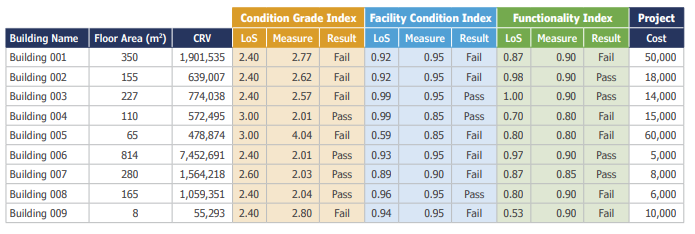Planning beyond condition
Download the full case study here or see Russell's presentation from the IPWEA Conference in Hobart here.
Background
One of SPM Assets’ customers is a large local government organisation in New South Wales, Australia. This Council is responsible for more than $3.0 billion of community assets, with a large property portfolio including buildings and structures such as; public swimming pools, childcare centres, community centres, libraries, public toilets, shade structures, and park amenities.
The goal
Council had a defined goal to develop and implement an assessment programme to inform a more strategic, equitable, transparent and sustainable approach for the management of their building assets. Council knew that their buildings were well-maintained through their traditional methods of prioritising works programmes but may not be meeting all the needs of the community. This was due to the perspective that much of the work needed was not related to the condition of the building; rather, it was about making its assets relevant and useful to the community.
The challenges
It became evident that a new solution that factored in the functionality of a facility, as well as its condition was required. Council produced a comprehensive specification that was put to the market to further clarify and assist with the process. They sought to confirm that they provided the community with facilities that were relevant and well maintained, and that met the requirements of its Community Strategy Plans. However, it was unclear on how this process could deliver the desired results on limited budgets, especially as there were issues around the quality of the asset data Council already had. The key need was to align budgets with community demands. Examples of facilities that needed investment due to functionality rather than purely on condition include:
- Sports facilities: Originally many facilities were constructed for male sports, but an increasing interest in female cricket and female rugby league, for example, meant modifications were needed to changing areas, showers and toilets.
- Childcare facilities: Needed to install adequate parking directly outside, so parents could safely drop off children.
- Libraries: Ensuring access is via a level pathway, and both stair and ramp access is present to the entry/exit. A lift should be present in multi-storied buildings.
- Public Toilets: Toilets have adequate lighting (interior & exterior), whilst are clean and well ventilated.
Our Solution
Using Council’s comprehensive specification as a basis, they undertook a collaborative approach with SPM Assets. An innovative and industry-best-practice solution to asset management planning was implemented. This solution focused on combining key asset management principles, written within IPWEA Practice Note #3 ‘Building Condition and Performance Assessment Guidelines’ and the NAMS Property eManual, with SPM Assets’ asset planning software application. The key stages included:
- Individual workshops with each building group to further determine Levels of Service and Quality Standards across Council’s 19 different building category groups.
- SPM Assets conducted infield assessments across the portfolio, assessing the condition, defects, and functionality.
- Analysis of asset data to determine quality shortfalls at both a building category and individual building level.
- Consultation workshops with Building Managers to work through the assessment results, building standards, and current works programmes.
- Building Managers were given the ability to amend their works programme to be inclusive of the assessment project results.
- Asset data was updated within Council’s systems following the completion of the assessment project.
Working closely with Council on this project, SPM Assets has set up a process to maintain the information and works-programming through a continuous improvement process. This process will also include a reassessment of Council’s facility on a rotating program every 4-5 years.
Quality Standards combine condition with functionality requirements
A key outcome for Council within the project were the Quality Standard (QS) criteria that established whether a building asset was either ‘below’, ‘achieving’ or ‘exceeding’ the established standard. This type of analysis had never been completed before for Council, in which the QS was modelled around both condition and functionality indices, as per below:
- Condition Grade Index (CGI): A weighted condition rating for each building asset that considers the condition of the assessed components against the replacement cost.
- Facility Functionality Index (FFI): A weighted functionality rating in which the value of functionality shortfalls is measured against the value of the asset.
Each building assets Quality Standard was measured by two different indices; CGI and FCI. Where a facility was seen to fail any of the indices, a rectification project/cost was identified to bring the asset back to standard.
The following table lists a selection of buildings – it shows:
- Current measures – the results of the assessment;
- The standard – the level of service standard that Council has assigned to each building type ;
- Position – confirming whether the building has passed or failed the standard;
- Project cost – the cost determined through the 7 point framework to address the shortfalls; and
- CRV – the capital replacement value of the building.
It shows that in many cases, the cost to address the shortfalls are quite minor when compared to the CRV – a small work item can greatly improve the quality of a building and be appreciated by its occupants and the community. The key part of this is to understand what’s needed and to decide on what’s important to the occupants, community and Council.

SPM Assets’ software is unique in that it created a list of planned-projects that factored in QS requirements, thus identifying buildings that need work now to bring them up to their required standard. The following software and solutions were used:
- Asset register at a space and building level
- Establishing Property Quality Standards (PQS) as referenced templates
- Use of Mobile to assess components and PQS
- Analysis of component data with Lifecycle algorithms
- Applying standards to understand the current and future shortfalls
- Using Project Planning to establish the works programme
- Use of Advanced Reporting to share the results in a compelling way
- Extracting the data with Data Flow models for upload to the corporate Asset Management system
The benefits
Council now has a new level of data as a result of implementing the innovative and industry-aligned assessment approach from SPM Assets – enabling ‘planning beyond condition’. Over 1,000 buildings have now been assessed, with centralised data and reporting tools improving the quality of decision making – the right projects at the right time for the right reasons.
Through applying Quality Standards across its portfolio, Council has been able to gain a more complete understanding of how the portfolio is performing, in terms of both condition and functionality. It is also able to estimate the expenditure needed to bring a building back to standard. Council can now prioritise its budgets, and is able to identify the on-going lifecycle costs of an asset well into the future.
Confidence in the planning process has been greatly improved. However, the greatest benefits are being enjoyed by the community, as the overall project will ensure that Council’s facilities are well maintained, practical, usable, and fit for purpose well into the future.
Next steps
Council is progressively working through the asset information and findings from the assessments, in which the evidence-based information is slowly being implemented into Council’s maintenance and capital works programmes where it is further supporting and justifying works moving into the future.
